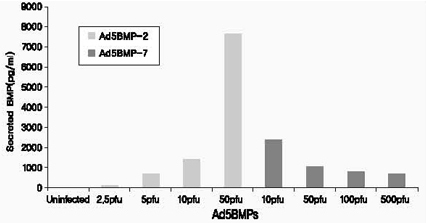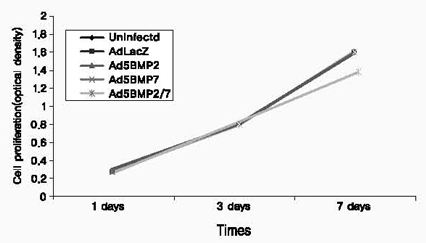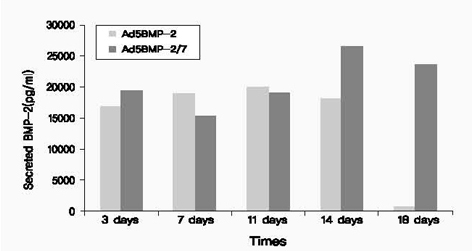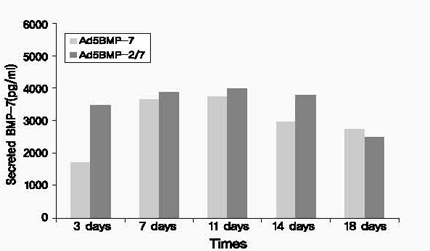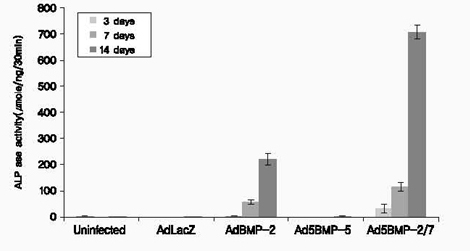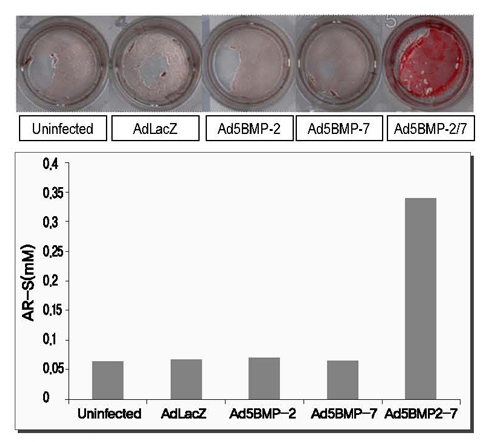J Korean Acad Periodontol.
2009 Aug;39(Suppl):279-286.
Effect of combinatorial bone morphogenetic protein 2 and bone morphogenetic protein 7 gene delivery on osteoblastic differentiation
- Affiliations
-
- 1Department of Periodontology, School of Dentistry, Seoul National University, Korea. ymlee@snu.ac.kr
- 2Department of Periodontics, Asan Medical Center, Korea.
Abstract
-
PURPOSE: Gene therapy (ex vivo) has recently been used as a means of delivering bone morphogenetic proteins (BMPs) to sites of tissue regeneration. In the present study, we investigated the effect of co-transduction of adenoviruses expressing BMP-2 and BMP-7 on osteogenesisof C2C12 cells in vitro.
METHODS
A replication-defective human adenovirus 5 (Ad5) containing a cDNA for BMPs in the E1 region of the virus (Ad5BMP-2 and Ad5BMP-7) was constructed by in vivo homologous recombination. Functional activity of Ad5BMP-2 and Ad5BMP-7 were evaluated in mouse stromal cells (W20-17cells). C2C12 cells are transduced with various MOI (multiplicity of infection) of Ad5BMP-2 and Ad5BMP-7 to assess most effective and stable titer. Based on this result, C2C12 cells were transduced with Ad5BMP-2 and Ad5BMP-7 alone or by combination. BMPs expression, alkaline phosphatase (ALPase) activity, cell proliferation, and mineralization were assessed.
RESULTS
Ad5BMP-2 and Ad5BMP-7 are successfully transduced to W20-17 cells, and secreted BMPs stimulated cell differentiation. Also, C2C12 cells transduced with Ad5BMPs showed expression of BMPs and increased ALPaseactivity. In all groups, cell proliferation was observed over times. At 7days, cells co-transduced with Ad5BMP-2 and Ad5BMP-7 showed lower proliferation than the others. C2C12 cells co-transduced with Ad5BMP-2 and Ad5BMP-7 had greater ALPaseactivity than that would be predicted if effect of individual Ad5BMPs were additive. Little mineralized nodule formation was detected in cells transduced with individual Ad5BMPs. In contrast, Ad5BMP-2 and Ad5BMP-7 combination stimulated mineralization after culturing for 10 days in mineralizing medium.
CONCLUSIONS
Present study demonstrated that adenoviruses expressing BMPs gene successfully produced BMPs protein and these BMPs stimulated cells to be differentiated into osteoblastic cells. In addition, the osteogenic activity of Ad5BMPs can be synergistically increased by co-transduction of cells with Ad5BMP-2 and Ad5BMP-7.
MeSH Terms
-
Adenoviridae
Adenoviruses, Human
Alkaline Phosphatase
Animals
Bone Morphogenetic Protein 2
Bone Morphogenetic Protein 7
Bone Morphogenetic Proteins
Cell Differentiation
Cell Proliferation
DNA, Complementary
Durapatite
Genetic Therapy
Homologous Recombination
Mice
Osteoblasts
Osteogenesis
Regeneration
Stromal Cells
Viruses
Alkaline Phosphatase
Bone Morphogenetic Protein 2
Bone Morphogenetic Protein 7
Bone Morphogenetic Proteins
DNA, Complementary
Durapatite
Figure
Reference
-
1. Lee MB. Bone morphogenetic proteins: background and implications for oral reconstruction. A review. Journal of clinical periodontology. 1997; 24:355–365.
Article2. Graves DT, Cochran DL. Periodontal regeneration with polypeptide growth factors. Curr Opin Periodontol. 1994; 178–186.3. Wozney JM. The potential role of bone morphogenetic proteins in periodontal reconstruction. J Periodontol. 1995; 66:506–510.
Article4. Khan SN, Bostrom MP, Lane JM. Bone growth factors. Orthop Clin North Am. 2000; 31:375–388.
Article5. Reddi AH. Bone morphogenetic proteins: from basic science to clinical applications. J Bone Joint Surg Am. 2001; 83-A:Suppl 1. S1–S6.
Article6. Winn SR, Hu Y, Sfeir C, Hollinger JO. Gene therapy approaches for modulating bone regeneration. Adv Drug Deliv Rev. 2000; 42:121–138.
Article7. Anusaksathien O, Giannobile WV. Growth factor delivery to re-engineer periodontal tissues. Curr Pharm Biotechnol. 2002; 3:129–139.
Article8. Ramseier CA, Abramson ZR, Jin Q, Giannobile WV. Gene therapeutics for periodontal regenerative medicine. Dent Clin North Am. 2006; 50:245–263.
Article9. Karthikeyan BV, Pradeep AR. Gene therapy in periodontics: a review and future implications. J Contemp Dent Pract. 2006; 7:83–91.
Article10. Franceschi RT, Yang S, Rutherford RB, Krebsbach PH, Zhao M, Wang D. Gene therapy approaches for bone regeneration. Cells Tissues Organs. 2004; 176:95–108.
Article11. Nishimatsu S, Thomsen GH. Ventral mesoderm induction and patterning by bone morphogenetic protein heterodimers in Xenopus embryos. Mech Dev. 1998; 74:75–88.
Article12. Cho TJ, Gerstenfeld LC, Einhorn TA. Differential temporal expression of members of the transforming growth factor beta superfamily during murine fracture healing. J Bone Miner Res. 2002; 17:513–520.
Article13. Zhao M, Zhao Z, Koh JT, Jin T, Franceschi RT. Combinatorial gene therapy for bone regeneration: cooperative interactions between adenovirus vectors expressing bone morphogenetic proteins 2, 4, and 7. J Cell Biochem. 2005; 95:1–16.
Article14. Zhu W, Rawlins BA, Boachie-Adjei O, et al. Combined bone morphogenetic protein-2 and -7 gene transfer enhances osteoblastic differentiation and spine fusion in a rodent model. J Bone Miner Res. 2004; 19:2021–2032.
Article15. Urist MR. Bone: formation by autoinduction. Science. 1965; 150:893–899.
Article16. Amar S, Chung KM, Nam SH, Karatzas S, Myokai F, Van Dyke TE. Markers of bone and cementum formation accumulate in tissues regenerated in periodontal defects treated with expanded polytetrafluoroethylene membranes. J Periodontal Res. 1997; 32:148–158.
Article17. King GN, Hughes FJ. Bone morphogenetic protein-2 stimulates cell recruitment and cementogenesis during early wound healing. Journal of clinical periodontology. 2001; 28:465–475.
Article18. Fiorellini JP, Howell TH, Cochran D, et al. Randomized study evaluating recombinant human bone morphogenetic protein-2 for extraction socket augmentation. J Periodontol. 2005; 76:605–613.
Article19. Kim KH, Park YJ, Lee SC, et al. A study of bone morphogenetic protein(BMP)-2 gene transduced periodontal cells for bone formation in vitro. J Kor Academy Periodontol. 2005; 35:511–524.20. Cheng H, Jiang W, Phillips FM, et al. Osteogenic activity of the fourteen types of human bone morphogenetic proteins (BMPs). J Bone Joint Surg Am. 2003; 85-A:1544–1552.
Article
- Full Text Links
- Actions
-
Cited
- CITED
-
- Close
- Share
- Similar articles
-
- Purification of porcine bone morphogenetic protein
- The experimental study on the effect of pulsating electromagnetic fields in the osteoinduction induced by bone morphogenetic protein
- Effect of composite of bone morphogenetic protein and plaster of paris on healing of bone defect in the rat tibia
- Bone Morphogenetic Protein-2 Desensitizes MC3T3-E1 Osteoblastic Cells to Estrogen Through Transcriptional Downregulation of Estrogen Receptor 1
- Effect of protein transduction domain fused-bone morphogenetic protein-2 on bone regeneration in rat calvarial defects

